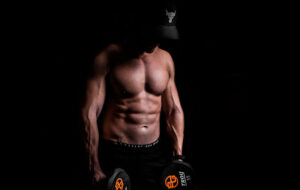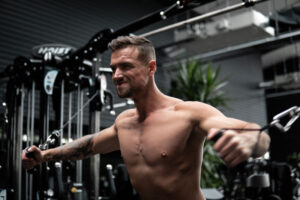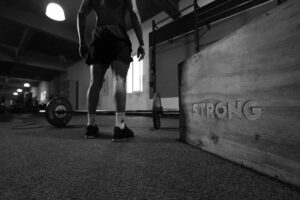You’ve probably heard the term hypertrophy bandied about, right? It’s all over social media. But what does it actually mean?
It’s the physiology of gains. It’s just the scientific term for ‘building muscle’, and hypertrophy just describes the process of tissue stimulation and repair. The principle is relatively simple: lift progressively heavier weights, create a calorie surplus, get enough rest, and your body will build larger muscles to cope with the increasing loads.
Intrigued? Read on to find out everything you need to know about hypertrophy training and how to supersize your gains.
What is hypertrophy?
Hypertrophy simply describes the growth of muscle cells through exercise; when we train, we’re creating tiny micro-tears in our muscles. As we recover, we’re repairing these minor tears so the muscles will grow back bigger and stronger.
Our muscles are made up of fibers that have been bound together in groups of tissue. When the cells in those fibers are activated by trauma (such as exercise), your immune system will trigger a response to start repairing the damage. Simultaneously, your body releases testosterone and growth factors. Testosterone boosts the creation of protein molecules that repair your injured tissues, and growth factors instruct your cells to thicken the muscle fibers. This process is also known as protein synthesis. And you end up with larger, stronger muscles.
So, why doesn’t all lifting result in hypertrophy? Because if you’re building strength, you’ll likely be focusing on low reps and heavy weights. If you’re training for endurance, you’ll probably be doing low weights and high reps to boost your performance. For hypertrophy, the optimum is somewhere in the middle.
What is hypertrophy training?
Essentially, hypertrophy training maximizes muscle growth. You’ll be using a mix of compound and isolation exercises to ensure you’re working multiple muscle groups and giving specific muscle groups their time.
The compound exercises initiate a powerful hormonal response post-resistance training. Whilst isolation exercises provide a way to apply more targeted volume to a muscle, such as your biceps or triceps.
When following hypertrophy training, there are a few things to consider:
- Volume – Research has indicated that higher training volumes are necessary to maximize anabolism. Plus, multi-set protocols favoring high resistance training volumes optimize your hypertrophic training.
- Frequency – The number of times a muscle is worked per week counts. Split routines will allow you to work out a muscle more often each week.
- Load – The intensity of the lift is widely considered the most essential factor in the hypertrophy response. Although, don’t lift heavy 24/7, you need to mix it up.
- Rest – Rest is important, and experts recommend at least two minutes between compound moves and 60 to 90 seconds for isolation moves.
How your genetics affect hypertrophy
It’s probably not what you want to hear, but the primary factor that determines how much muscle you can build is down to your genetics. But you can still maximize your gains by training hard, eating well, getting high-quality sleep, and managing stress.
When you’re working out regularly and doing everything necessary to make gains, you can get impatient. Still, it’s important to understand that it can take a long time to build significant muscle. Most of the physiques we see on bodybuilding stages took 10 to 20 years of training to get where they are. Gains are a marathon, not a sprint.
What’s the difference between working out for strength and hypertrophy?

There’s a lot of overlap in training for strength and hypertrophy, especially in newer gym-goers. However, the more advanced you become, the more specific you need to train for your goals.
For example, if you train in the six to 12 rep range, you’re probably building strength and muscle simultaneously. However, long-time lifters who want to boost size and strength should add training days in the 2-5 rep range and lift at around 80% of your 1RM.
As well as making you stronger, hypertrophy training has numerous other benefits, such as your overall quality of life.
What’s the hardest muscle to build?
Calves, forearms, triceps, and obliques are renowned for being tricky to grow, your capacity to pack on mass is primarily genetic. Some guys simply have an easier time developing specific muscles than others.
Popular safe and legal steroid and SARMs alternatives
How to maximize hypertrophy gains

Effective hypertrophy means finding the balance between training, nutrition, and recovery. You are shifting damages to your muscle fibers, forcing your body to repair them thicker. To work this magic, you’ll require extra calories.
Rest is the final piece of the puzzle because your body needs time to repair the damage you’ve created.
How to train
Keep challenging your muscles with progressive overload. Each session increases the strain placed on the muscle from the previous week or session. For example, if you squatted 100kg for ten reps last week, and this week you do 11 reps, that is a more significant stimulus.
Plus, structure your training by targeting each muscle group twice per week.
What to eat?
Remember, your body needs fuel and plenty of it. In fact, recent research suggests the energy cost of building muscle is around 400 to 500 calories a day.
Ensure that you’re also staying hydrated – aim for 1ml of water for every calorie burned throughout the day.
Resting and recovery
Rest is crucial for hypertrophy. After all, if you’re not recovering, you’re not growing muscle. Remember, you’re only in the gym for a fraction of your day; what you do with the rest of your day is what makes the difference.
The ultimate full body hypertrophy workout
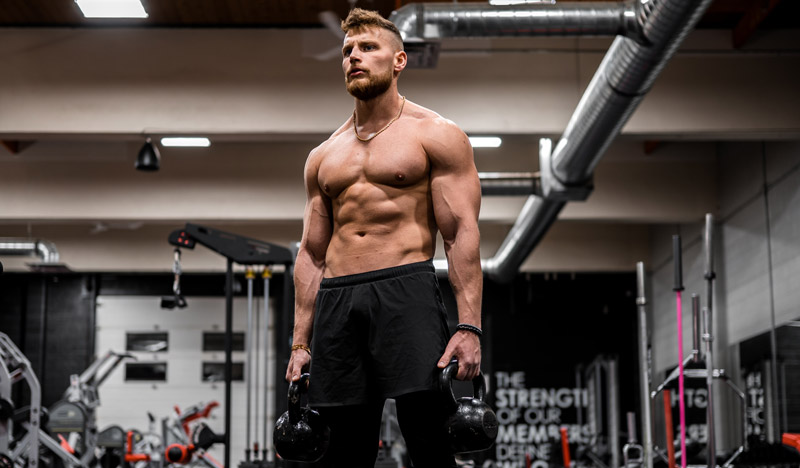
Ready to make gains? Well, this hypertrophy workout will grow your entire body in one punishing swoop!
After you’ve warmed up, follow the below exercises in order. Make sure you note the sets, reps and rest for each move.
Back Squat – 4 sets, six reps. 90-second rest in-between sets
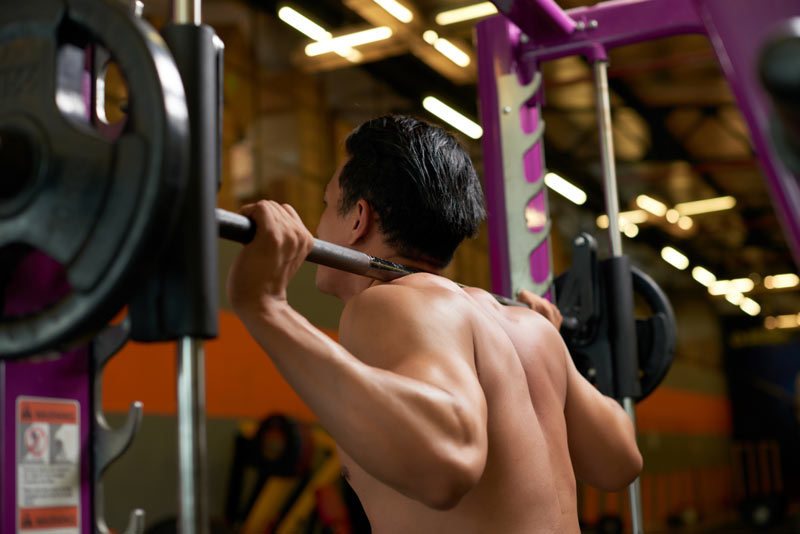
Start by standing with your feet more than shoulder-width apart and hold a barbell across your upper back with an overhand grip.
Hug the bar into your traps so you engage your upper back muscles. Slowly sit back into a squat with your back straight, head up, and backside out. Continue to lower down into the squat until your hips are aligned with your knees, and your legs are at 90 degrees. Push your heels into the floor to explosively drive yourself back up.
Barbell Romanian Deadlift – 3 sets, eight reps. 90-second rest in-between sets
Start with a barbell in front of your thighs and draw your shoulders back with a straight spine. Slowly lower the barbell to the ground and push your hips back. Make sure to keep your chest high and open.
When the barbell is below your knees, thrust your hips and then return to the starting position.
Flat Dumbbell Bench Press – 4 sets, six reps. 90-second rest in-between sets
Begin by lying on a flat bench with two dumbbells over your chest and a shoulder-width overhand grip. Face your palms towards your feet.
Press the weights above your chest, extend your elbows until your arms are straight. Then lower the dumbbells slowly back to the starting position until they skim the middle of your chest.
Neutral Grip Pull-up – 3 sets, AMRAP. 90-second rest in-between sets
Grab the handles of the pull-up machine with your palms facing away from you, about shoulder-width apart and your arms fully extended.
Squeeze your shoulder blades together, exhale, and then drive your elbows towards your hips to bring your chin above the bar. Maintain control as you lower down to the starting position.
Bulgarian Split Squat – 3 sets, ten reps. 60-second rest in-between sets
With one leg resting on the bench behind you, laces down and your front foot two or three footsteps from the bench. With your standing leg, squat down until the knee of your rear leg almost touches the floor – lower the bench if your knee doesn’t reach the ground.
Drive up explosively through your front foot to return to the start position.
Dumbbell Lateral Raise – 3 sets, 12-15 reps. 60-second rest in-between sets

With two dumbbells by your sides with palms facing the body. Keep your upper body still and lift the dumbbells out to your side with a slight bend at your elbows. Lift until your arms are parallel with the floor, hold for a second and then slowly lower to the start position.
Chest-Supported Dumbbell Row – 3 sets, 15 reps. 60-second rest in-between sets
Lie face down on a bench with your feet on either side. Using a neutral grip, hang the dumbbells beneath you and keep your head up. As you pull the weights towards your chest, bring your shoulder blades together. Maintaining control, lower to the starting position.
Lying EZ Bar Skullcrusher – 3 sets, 10-12 reps. 60-second rest in-between sets
Using the overhand position, grasp the inner grips of the EZ bar and extend your arms straight up. Making sure to keep your elbows fixed and tucked in, slowly lower the bar until it is about an inch from your forehead. Hold for a second before slowly raising your arms back to the starting position without locking your elbows.
Incline Dumbbell Curl – 3 sets, 10-12 reps. 60-second rest in-between sets
Start by sitting on a bench set to 45-degrees, in an underhand grip hold two dumbbells down at your sides. Next, begin to curl the weights up to your shoulder height, squeeze your bicep and hold for a second, before then return under control to the start position.
Seated Calf Raise – 3 sets, 15-20 reps. 45-second rest in-between sets
At the leg press machine, rest your feet so that your toes are resting at the bottom of the platform and the rest of your feet are hanging off. Push back as far as you can but keep your feet flush against the platform. Hold for a second, and then keep control as you return to the start position, and repeat.
Hanging Leg Raise – 3 sets, 10-15 reps. 45-second rest in-between sets
Grab a pull-up bar, lower yourself into a dead hang and let your legs straighten. Pull your pelvis back, tense your core and raise your legs until your thighs are perpendicular to your torso. Hold for a few seconds before lowering slowly back to the starting position.
Get Brutal

Ready to make gains following a hypertrophy routine and enhance your performance in the gym? Of course, you are.
Well, you can get all that and more with Brutal Force. Our 100% natural bulking supplements and SARMs are entirely legal, safe, and free of any side effects. And there’s no prescription in sight!
It’s time to get BRUTAL – the right way.





